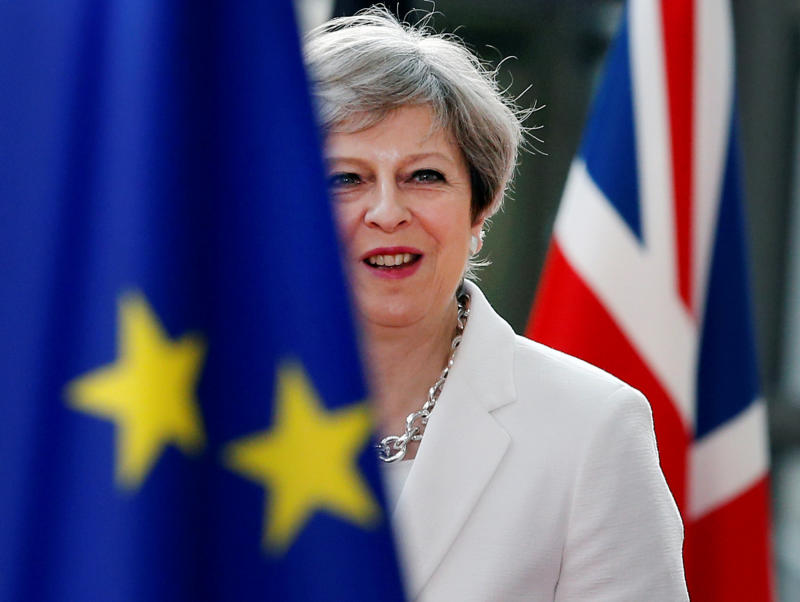PM Theresa May unveils Britain's soft Brexit blueprint, but banks cut loose
Sign up now: Get ST's newsletters delivered to your inbox

British Prime Minister Theresa May published a 98-page "white paper" setting out in detail the deep trading partnership Britain wants with the EU.
PHOTO: REUTERS
Follow topic:
LONDON (BLOOMBERG) - Mrs Theresa May released the most contentious document of her two-year premiership on Thursday (July 12), vowing to push through her plan to keep Britain closely tied to the European Union single market after Brexit.
Despite the resignation of two pro-Brexit Cabinet ministers and a growing rebellion from within her own party, Mrs May published a 98-page "white paper" setting out in detail the deep trading partnership Britain wants with the EU.
At its heart is a proposal for a new Britain-EU "free trade area", with interlinked customs regimes, and identical regulations for industrial goods and agri-food. While there would be "no tariffs on any goods", Britain's vast services sector will suffer significant disruption. Banks in particular will lose their current access to the EU market, as the government gives up on its earlier plan for both sides to recognise each other's regulations.
Britain Calls on EU to Keep on Sharing Cyber Security and Data
Mrs May faces a huge task trying to persuade EU negotiators to accept that the proposals are viable, while also keeping her Conservative party and Parliament on side. Time is running out to reach an exit agreement by the self-imposed October deadline, and Mrs May's plan has nothing new about the critical issue that is holding up progress: Avoiding customs checks at the border with Ireland.
Even United States President Donald Trump took a view. Hours before he is due to touch down in Britain, he lobbed a verbal hand grenade at his host, saying Mrs May is not giving voters the Brexit deal they wanted.
'Brexit is Brexit'
"I would say Brexit is Brexit," Mr Trump said on Thursday at a news conference at the Nato summit in Brussels.
"The people voted to break it up so I would imagine that's what they would do, but maybe they're taking a different route - I don't know if that is what they voted for."
Mrs May appealed to European negotiators to "engage" with her blueprint in the same spirit of respect that she said her government was taking toward the EU's own principles and red lines.
Britain's May Drops Call for Easy Access by Banks to EU's Markets
"Our proposal is comprehensive. It is ambitious. And it strikes the balance we need - between rights and obligations," Mrs May wrote in the foreword to the white paper.
"It would deliver a principled and practical Brexit that is in our national interest, and the UK's and the EU's mutual interest."
Britain has also set out a complicated structure for supervision of the new relationship that would allow the two sides to discuss rule tweaks and include a mechanism for solving disputes.
ECJ Role
The British prime minister, European leaders and ministers would establish a "governing body" to set the direction of the future relationship, while a joint committee of officials would provide the day-to-day running of the agreement.
Crucially, in a move that could anger Brexiteers, if there is a dispute over the interpretation of EU rules that Britain has agreed to adhere to, the European Court of Justice (ECJ) could have the final say.
Details in the document include:
- Britain will mirror EU rules for goods, as well as collecting tariffs on behalf of the bloc. In a sign of the imbalance in the relationship, Mrs May is not proposing the EU collect tariffs on behalf of Britain.
- Britain proposes setting up new arrangements to allow it to have a voice - but not a vote - when EU introduces new regulations, and to facilitate the customs arrangement.
- On rules of origin which govern whether goods are treated as EU-made, Britain is asking for no changes to current arrangements. This is crucial for manufacturers including car-makers, who otherwise face tariffs when exporting to the EU.
- White paper sets out the parliamentary process after a deal has been agreed with the EU, and makes it clear that it will be conditional on support from lawmakers.
- Britain wants to keep participating in EU agencies covering chemicals, aviation and medicines. It also proposed a close cooperation with the European Maritime Safety Agency and new arrangements for a closer association with the Euratom nuclear regulator than any other non-EU country.
- Britain acknowledges its position on cooperation over the €10 billion (S$15.9 billion) Galileo satellite navigation programme is at odds with that of the EU. It maintains it wants to retain involvement in the project, in particular its Public Regulated Service - the encrypted navigation used for government and defence purpose, which the EU wants to exclude Britain from.
- On immigration, the document says Britain will continue to be "open and tolerant", while ending the free movement of people. It stops short of saying EU citizens will be prioritised in any future immigration system.
- Britain will also seek to ensure British and EU citizens can still use each other's health services when abroad, and foreign residents can still access their pension entitlements. Irish citizens will enjoy "special status" distinct from that of other EU nationals.

